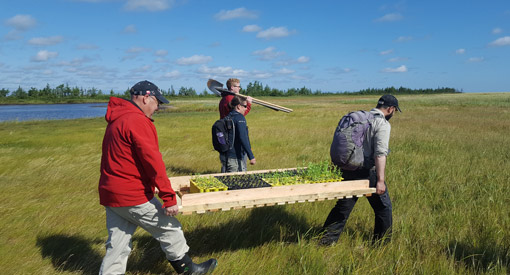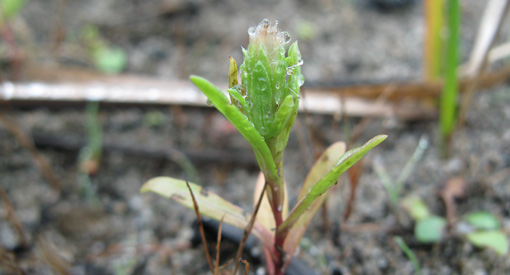
Gulf of St. Lawrence Aster Restoration
Kouchibouguac National Park
Aster (Symphyotrichum laurantianum)
SARA Status: Threatened
The Gulf of St. Lawrence Aster is small and fragile annual coastal plant found on brackish sand or mud in dune slacks, in sheltered salt marsh or on sandy beaches in protected coves. Although it can reach sizes of up to 40 cm, this often inconspicuous species usually only averages 3 to 5 cm in height. Gulf of St. Lawrence Aster has smooth elongate leaves, with small flower heads that range from a whitish to pinkish colour, and produces dry fruits called achenes. Much like those of Dandelions these achenes each bear a tuft of fine whitish hairs that help them get dispersed by wind.

The rare Gulf of St. Lawrence Aster is entirely endemic to the southern Gulf of St. Lawrence, which means it’s found nowhere else in the world. It has only been documented in the Magdalen Islands (Quebec), along New Brunswick’s eastern shore, and on Prince Edward Island’s north shore. Most occurrences of the species are located in the Magdalen Islands, with only a few small populations still known to exist in the Maritime Provinces. Survey data indicates that a significant portion of populations have been lost in recent decades, including half of all reported occurrences in New Brunswick. Due to its extreme rarity and recent decline, the species is presently considered Threatened by the Committee on the Status of Endangered Wildlife in Canada (COSEWIC) and is federally protected under the Species at Risk Act (SARA) since 2005.
Habitat

Photo: David Mazerolle
All known Gulf of St. Lawrence Aster populations occur in coastal habitats such as, lagoon shores, dune slacks and dry stretches of salt marshes. This annual plant grows in moist, mostly sandy soil, typically on gently sloping ground just above the high water line in areas with sparse vegetation. It’s fairly specialized in its habitat and doesn’t deal well with frequent exposure to salt, drought, or competition from other species. Essentially, this plant plays a dangerous game: it doesn’t tolerate storm waves and salt water flooding but relies on them to create its preferred habitat of open moist sandy shore.
Threats
Sea-level rise and climate change-related increases in storm frequency and intensity constitute the most important threat to this plant. Severe storm events can transform coastal habitats to the point where ideal habitat becomes completely unsuitable. Shoreline development has also caused significant habitat loss in the past. The documented loss of known occurrences and pronounced population decline underline the importance of continued survey, monitoring and restoration efforts in the conservation of the species.
Reintroduction Efforts
Kouchibouguac National Park was once home to Gulf of St. Lawrence Aster. In fact, since the late 1970s the species has been discovered at three separate locations within the park. However, a series of severe fall storms in the early 2000s drastically changed known population sites, making them largely unsuitable. Despite intensive yearly searches over more than a decade, in 2015 the species was finally declared no longer present in the park.
In 2016, Kouchibouguac National Park, in collaboration with the Atlantic Canada Conservation Data Centre and the University of Prince Edward Island, mounted a two-year project focused on the reintroduction of the species through the use of greenhouse-produced seed and transplants. Specifically, the project aimed to provide answers to the following questions: (1) Is suitable habitat still present within the park?, and (2) Is reintroduction of the species in Kouchibouguac National Park feasible and cost-effective?

Photo: David Mazerolle
Suitable habitat sites were identified and numerous seeding and transplant plots were established in 2016 and 2017. Fifty-five percent of seeding plots were productive in the year of seeding and 16% of plots have consistently produced substantial numbers of individuals over a three- or four-year period. From 2016 to 2019, seeding plots are confirmed to have produced a total of roughly 5,500 individuals which successfully reached reproductive maturity. Survivorship of plantlets averaged 72% in transplant plots; across all sites, an estimated 620 transplanted individuals successfully completed their life cycle.
Our results provide evidence that the park still contains habitat suitable for the species and that reintroduction is indeed feasible. After a 12 year-long absence, a self-sustaining population seems to have been restored in Kouchibouguac National Park! Knowledge gained from this project will inform future recovery efforts within the park and potentially throughout the range of the species.
Did you know?
The Gulf of St. Lawrence aster is exclusively found at a handful of sites in New Brunswick, Prince Edward Island and Quebec’s Magdalen Islands. It’s one of very few plant species to have originated in this part of the world after glaciers retreated roughly 10,000 years ago. Ultimately, the fate of this unique species is closely tied to how sea-level rise and climate change will unfold in the region.
Saving the Gulf of St.Lawrence aster in Kouchibouguac
Related links
- Date modified :